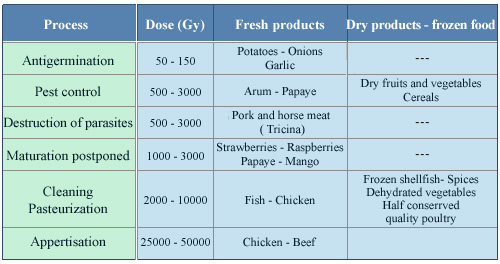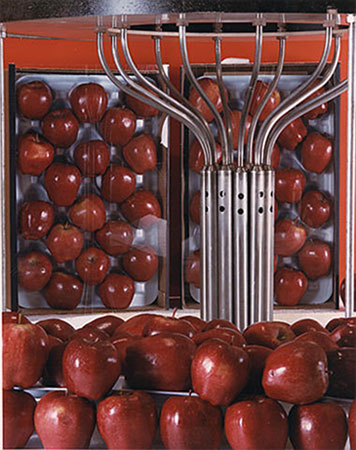A conservation process without additives, non radioactive

Table of doses
The doses used for the treatment of alimentary products are much stronger than those used in radiotherapy. For example, the lowest doses of 50 -150 Grays in the table, whilst similar doses administered locally for the treatment of a cancer tumour, would be considered very high, and lethal applied on the entire body. However, energy levels remain modest in absolute values. A dose of 1000 Grays (2,4kcal/litre) would raise the temperature of a litre of water only by 2.4°C
© Source SFEN
The biological effects of strong doses of radiation are used for the conservation of dietary products. In products to sterilise or to conserve, the path of radiation that destroys bacteria and other micro organisms does not leave any radioactivy behind. The only waste product left is a small amount of molecules that have been altered in the food by the passing of energy. For this reason irradiation by rays offers interesting possibilities for the conservation of food products.
When the radiation is applied in the prescribed doses to certain products, the process reduces the deterioration and poisoning of these product. The marketing of these irradiated products has been authorised in 40 countries; but not all. The commercialisation is supported by the World Health Organisation (WHO) and in the United States, by the Food and Drug Administration (FDA).
The irradiation of food products has advantages over other methods of conventional preservation. Firstly, radiation does not leave additives, as with preservatives. Fruits and vegetables keep their taste, texture, and nutritional value, in contrast to the consequences of cooking, freezing, the addition of preservatives, drying or setting into powder. The irradiation has been proven to be effective in neutralising the pathogens in chickens (Campylobacter), minced meat of beef (Cryptosporidium, E.Coli) as well as listeria, salmonella and toxoplasma.

Getting rid of insects in fruits
Disinsectisation of apple’s pests in an irradiation facility in the United States. The dose is low enough not to alter the appearance, taste and other qualities of the fruit, but enough to kill insects and worms that could further develop.
© Source PNL
The rays used for the irradiation of foods are X rays, gamma rays of colbat-60 or caesium- 137, or the electrons produced by a small accelerator. The results depend on the energy available, meaning the dose measured in Grays (Gy).
At a weak dose, irradiation helps to conserve certain food products where it destroys microorganisms and parasites. It is used to suppress germination (potato, onion, garlic, ginger), to get rid of insects and parasites in cereals, vegetable plants, dry and fresh fruit, fish and meat and to slow down the physiological process of fresh fruits and vegetables.
At a medium dose, radiation induced ionisation allows the conservation of fresh fishes, strawberries, the elimination of altering agents and micro-organism pathogens in seafood, chicken and meats (fresh or frozen products) and the improvements of foods, for example the increase in the use-by date for grape juice or the shortening of the cooking time of dried vegetables.
At a strong dose, ionisation allows the industrial sterilisation of meats, chicken and sea food, ready to eat foods, hospital rations and the decontamination of certain additives and ingredients such as spices, gum, and enzyme preparations.
Indeed irradiation of consumer products can be authorised because it does not leave any radioactivity behind.
NEXT : Disinfecting effects
Other articles on the subject « Applications of Radioactivity »
Inspection and controls
A tool for testing and tune-ups The penetrating property of radiations is commonly used to check [...]
Material Developmnent
Improvements in the quality of industrial products Every day we make use of products that have be[...]
Non Destructive Testing
Control of industrial processes and materials Tracers and radioactive sources are frequently used[...]
Food processing
Eradicate bacteria, fungi and pests with radiation … Gamma rays are used industrially to en[...]
Food Preservation
Conservation and preservation of food The effects of radiation on the cells of living or vegetabl[...]
Medfly Eradication
The curse of the medfly and its eradication The Mediterranean flies or Medflies are a dreadful cu[...]
Disinfecting Effects
Getting rid of parasites and germs….. The radiobiological action of radiation leads to damage to [...]
Radioactive Gauges
Instruments for industrial process control In order to be peforming and efficient; modern industr[...]
Sources in Industry
A wide variety of applications Most radioelements in radioactive sources are extracted from small[...]
Various Applications
Because of the fears it inspires, radioactivity is considered in the collective unconscious as ho[...]